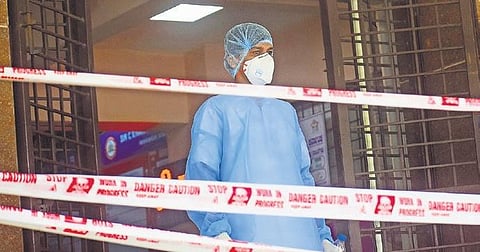

CHENNAI: Lessons learned from the HIV AIDS epidemic in India are aplenty. An important take-away that becomes useful in view of this Covid-19 pandemic is: The best medical efforts can go for a toss if the community fails to co-operate and acts in panic instead.
While the State is attempting its A-game in strengthening the healthcare, it is time to step-up its communication strategy and make information more transparent in order to make public willing participants in this fight, say experts, who were frontline workers during the HIV epidemic.
Resident welfare associations in city have been preventing entry of healthcare workers into apartments, large crowds gather in protest of burial of Covid-19 victims and thousands storm in panic buying groceries every time the lock down is strengthened. While these acts of public behaviour of self preservation and fear, ironically, the very act could put them at severe risk of contracting the disease.
Stigma against healthcare workers:
On April 19th night, hundreds of residents protested the burial of Dr Simon Hercules, who succumbed to Covid-19 at two different burial sites. Such acts of panic and stigma could have been avoided, if the State had pre-empted and informed the locals about the lack of risk of transmission from buried dead bodies and about the protocols followed during the burial of Covid-19 victim, says Dr. Shyamala Nataraj, founder and executive director of South India AIDS Action Programme (SIAAP).
"If there is an epidemic, there will be deaths. We have examples of such stigma from other countries. In addition to good medical and clinical work, the State should also pre-empt such confusion around death," she suggested. Nataraj says that this was just one example of how understanding the information needs of the public could have ensured their co-operation.
In case of HIV, people were largely aware of where their threat of contraction came from. "They stigmatised and targetted their fear at sex workers, transwomen and those who were promiscuous. In case of Covid-19, anybody and anything could be their threat. The most visible face of this threat are the health care workers as the patient is invisible," she said elaborating that this is the reason why doctors, nurses and paramedics are being stigmatised.
The science to communication:
Even as HIV and Covid-19 poses lethal risks to different demographics, the common thread that ties them is the outcome: fear of death and the economic havoc it wreaks. While it can be battled with infrastructure and healthworkers on one side, a strenghthened psycho-socio-economic plan is an urgent need at this point of the epidemic, says Dr Aiswarya Rao, a pediatrician and public health consultant who has worked in the field of HIV/AIDS treatments and prevention.
Following safe sex practices was an act of fight against HIV; similarly, staying indoors is an act of public fighting against Covid-19, says Dr Rao, adding that when the public are following a certain protocol in co-operation, they expect more transparency. "They are constantly thinking about the virus and expect clarity. For example, why was a sudden four day lock down announced? Is there need for panic? People have such questions in their mind," she says.
The tremendous efforts taken by the government will collapse if the public stop listening to the protocols, she opined pointing that while negative reinforcement with penalty will garner some co-operation, postive reinforcement will make them willing participants. "It is important that government constantly reminds people to wear masks, wash hands and social distance. Then what?" she asks.
Clear, standardised information:
Education on context specific information, transparancy of infection projections, pre-emptimg public confusion and evidence and rationale behind regulations, are some things that may bring public cooperation. "The government must be upfront and trust that people will understand. It is a two way-road. Plain fear and panic will only worsen the situation," says Rao.
Fear and panic, barely ever does any good in a pandemic, creative ways to fight the stigma associated with the pandemic, is the need of the hour, Rao points. "If we could fight stigma in HIV to this extent and bring responsible behaviour among public, it is certainly possible in case of Covid-19," she said.
For example, along with demarcating containment zones and putting stickers on positive patients' house, the government should create pride slogans on how a person is keeping the community safe by staying indoors, says Rao. "Quarantine itself should not become a source of stigma and confusion. People are likely to report themselves, if they see it as an act of pride, as opposed to discrimination," she said.